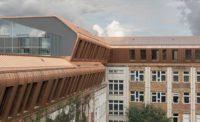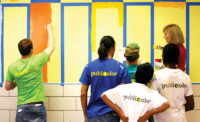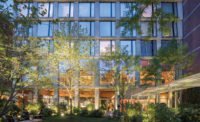Just blocks from New York's Flushing Meadow Park—home to the 1939 and 1964 world's fairs as well as the Billie Jean King National Tennis Center and the Mets' Citi Field baseball stadium—Public School 330 is a local attraction in its own right. This cheerful elementary school in Corona, a neighborhood in the borough of Queens, not only provides much-needed classrooms here but also opens a window onto the education of the community's children.
By the fall of 2013, the children were able to walk to a new school. Designed by the New York'based Murphy Burnham & Buttrick for 420 kindergarten through 5th-grade students, the 65,000-square-foot building spans a city block on a former parking lot between a commercial thoroughfare and a cluster of low-rise houses and apartment buildings. The site is 211 feet long and ranges in width from 136 feet on its west side to a scant 88 feet on the east. In order to accommodate the programmatic and logistical requirements specified by the New York City School Construction Authority (SCA), the architects negotiated the quirky site by stacking the four-story steel superstructure along its north edge. They situated the main entrance, offices, restrooms, mechanical closets, and ancillary teaching spaces on the busy (and noisy) street side. Then they placed classrooms, shielded by external sun louvers, on the quiet south side, where they were also able to fit a requisite double playground for older and younger kids. Mindful of the project's tight construction schedule, the design team requested a variance from the SCA's standard brick cladding, swapping it for a simple facade made of precast concrete panels hung above a base of staggered red bricks, which was erected in two weeks without scaffolding.
The resulting trapezoidal building is light and airy, and establishes an immediate connection with the community via friendly patterns of fenestration that encourage views inside and out. Vertical slices of window wall reveal brightly colored stairwells as well as the school library, where artist Terence Gower's sculptural tribute to onetime Queens resident Isamu Noguchi floats from a double-height portion of the ceiling. (It was commissioned by the Public Art for Public School program.) At ground level, horizontal runs of high-impact exterior glazing and interior windows allow passersby to look directly through the building to the playground out back, into the cafeteria, and down to a glass-enclosed gym/auditorium in the basement. Dubbed the “gymatorium” by the architects, this space holds up to 314 occupants and has a stage-cum-dance studio at one end.
Newcomers feel welcome when they enter the bright green portal for the first time. The floor plan is logical and clear—with offices to the right, the schoolyard door straight ahead, and a path to the cafeteria (overlooking the gym) on the left. The firm's thoughtful use of materials, such as wood slats for the ceiling throughout these public areas, results in a warm environment with a unique sense of bonhomie for a New York City public school.
“We leveraged the common spaces to make them perform with maximum utility,” says partner in charge Jeffrey Murphy. “Linking the gym, cafeteria, lobby, and playground creates a bigger space for school-wide activities and community events,” he adds. An extra-wide 13-foot corridor (the SCA standard is 8 feet) with quartz-topped window seats manages spillover, doubles as a waiting area for visitors, and aids traffic flow when kids are entering or exiting the building.
Daylight and the judicious use of color contribute to the atmosphere of well-being. “We used the sunken gym as a light well around which a lot of things circulate,” says Murphy. “Even when the kids go downstairs, they can look up, see the street and know where they are.” Similarly, each of the upper floors is color-coded to help wayfinding—green on the second floor, orange on the third, blue on the fourth—with colorful patches of vinyl tile and matching bench tops adjacent to the expansive windows that flank the halls on every level.
Comfortably settled in their school for over a year now, the students enjoy vistas of the park during class time and can watch planes landing at LaGuardia Airport from the library. They can even see Manhattan on clear days from the building's west side. “They love it,” says principal LaShawnna Harris, “especially the kids who were in the old building.”
The families are just as enthusiastic, she notes. “They're really excited to be able to see what's going on with their kids. We are constantly getting parents, especially at the beginning of the school year, who line Northern Boulevard in the morning and stay for 30 minutes just watching the kids in the gym or walking down the hallway.”
People
Formal name of building:
Location:
Completion Date:
Gross square footage:
Total construction cost:
Client:
Owner:
Architect:
Personnel in architect's firm who should receive special credit:
Engineers:
Consultant(s):
Other:
Photographer(s): Size: 65,000 square feet Construction cost: $36 million Completion date: September 2013 |
Products
Cladding:
Windows:
Interior Finishes: |




















Post a comment to this article
Report Abusive Comment